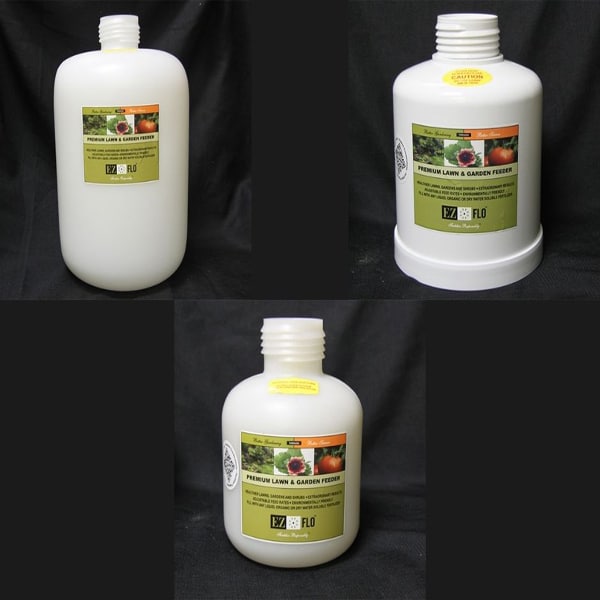It’s Proven– EZ-Flo tanks feed gently, in small “Micro Dosing” amounts , with each watering, giving the plants a healthier root system that makes them stronger, more drought tolerant and less susceptible to insects and diseases.
- These Tanks are part of the 2000 series.
- Only install in on/off pressure applications where the system is only under pressure when in use!
- See Next Product for Constant Pressure Systems.
- Do not use over 50 PSI. Do not let Freeze.
- See above for Brochures and Feeding Charts
- EZ Flo Feeding Chart (Example below)
Forget using watering cans, backpack sprayers, and plain old water, join thousands of other Americans using EZ-FLO to boost the health and look of their lawns, vegetable plots, and gardens. Simply fill EZ-FLO with your chosen fertilizer or nutrient and start utilizing every drop of water from your garden hose to deliver the nutrients and fertilizer your plants and lawn need.
Hose Bib units can be used by any homeowner, nursery or grower simply by attaching it to a standard water faucet. All parts for installation are included with the system. However, if installing without the included connector, a CBV is required for proper injection.
Gardeners have long loved this unit for its ability to feed its flowers, trees, and shrubs without constantly refilling the tank. It can be moved around to feed multiple areas.
**Please note, do not put this tank on a main line. We have a range of other options suited for this. Maximum 50 psi
| Feed Rate Ratio Setting Tank Capacity Gallons to Empty Slow 1000 to 1 .75 gal 1000 x .75 = 750 #1 500 to 1 .75 gal 500 x .75 = 375
|
GENERAL FERTILIZER APPLICATION RATES:
Apply 3.5 lbs of 20-20-20 per 1,000 feet per week. Once you have fruit set, apply 5 lbs. per 1,000′ of 16-3-26 with Calcium. ** If you are growing Tomatoes & Peppers, you should spray them every week with Calcium Chelate at a rate of 2 oz per 1,000 feet.
REMEMBER!! More is not always better! I have killed more with fertilizer, than I have helped!
*** Soil Tests are recommended. Ask your Local Extension Agent about leaf samples and soil samples. They can also make specific recommendations to your region.
Can I use Organic Fertilizer?
EZ-FLO studies have shown EZ-FLO units efficiently deliver even the heaviest organic products. The internal flow ports of the system are large and protected by a fine, non-clogging screen. This screen prevents downstream clogging in your drip emitters or spray heads. If the desired organic is oil-based (lighter than water), the unit may not be able to pull the mixture since the pickup tube pulls from the bottom of the tank.
Is this Easy to Use?
EZ-FLO Hose and Drip systems can be installed in minutes by the average homeowner and are great for use when you don’t have a dedicated irrigation system or want to separately address certain types of plants that require specialty garden fertilizers and supplements.
The standard hose installation includes the hose bib adapter. If the hose bib is not separately protected from backflow then a standard anti-siphon valve will also need to be purchased (Part #3050). In order to convert a Hose and Drip feeder to single sprinkler zone connection, a separate EZ-FLO Ball Valve Coupling connection is available for purchase.
| Looking for a more Commercial Unit? The Constant Pressure Unit is made for constant pressure but is also a thicker tank. ONE GALLON CONSTANT PRESSURE UNIT — EZ-FLO 1010-HB One gallon hose drip system for constant pressure installations.
|
Micro-Dose Proportioning
EZ-FLO Fertigation technology has been in development over the last ten years. As of 2007, EZ-FLO has received 9 issued US Patents and 2 International Patents covering its unique fluid flow technologies and has tens of thousands of units operating in actual field use. Our patents cover the connection couplings as well as the flow process whereby fertilizer is accurately proportioned in the tank cap for release to the irrigation water stream.
One of the unique attributes of an EZ-FLO system is its ability to precisely proportion fertilizer concentrate into a water stream in an extremely accurate manner. We call this “Micro-Dosing”. Not only is the amount of fertilizer concentrate proportioned accurately but the individual fertilizer elements of N-P-K are also in consistent ratios when exiting the irrigation system from beginning of the fill cycle to the end of the cycle.
Many people erroneously assume that fertilizer in the EZ-FLO tank is simply diluted as it goes through an entire cycle. However as can be seen above, dilution does not really occur in the way most people think. Almost all of the dilution occurs in the tank cap where we can control it and in the irrigation line where the nutrified water rejoins the rest of the clear water.
EZ-FLO’s patented flow technologies effectively create an “invisible bladder” that separates the clear water entering the tank from the fertilizer concentrate at the bottom of the tank. As clear water is introduced into the tank, it arrives in a number of areas. Port water inlets at the top of the tank create a clear layer of water that separates it from the fertilizer concentrate. Additionally a micro-jet agitation nozzle at the bottom of the tank “gently” agitates the heavier fertilizer concentrate, keeping the resulting semi-dissolved solution at even chemical concentration levels leaving the tank. Because of this ‘invisible bladder effect” there is no real dilution of the suspended N-P-K in the tank through out most of the tank cycle. Only when you get to the end of the tank contents do the NPK percentages fall off.
As shown in the graph under the table, EZ-FLO technology results in a level application rate and there is no concentration/dilution “spike” as occurs in other proportioning systems that have direct mixing of fertilizers with water.
Independent Testing Results
EZ-FLO secured the testing services of the JR Peters Laboratory (a Scotts Miracle-GRO Company affiliate) to document the consistency of the N-P-K release using EZ-FLO technology. The result of this independent lab testing is shown graphically above during the “full to empty” cycle. As can be seen, there is no initial spike in parts per million (PPM) as occurs with other mixing systems. Additionally the N-P-K parts per million remains relatively constant until the tank evacuates at the end of the cycle. Only then, do the parts per million fall off, but that is in the last 5-10% of the cycle when the tank is almost empty of fertilizer concentrate.




